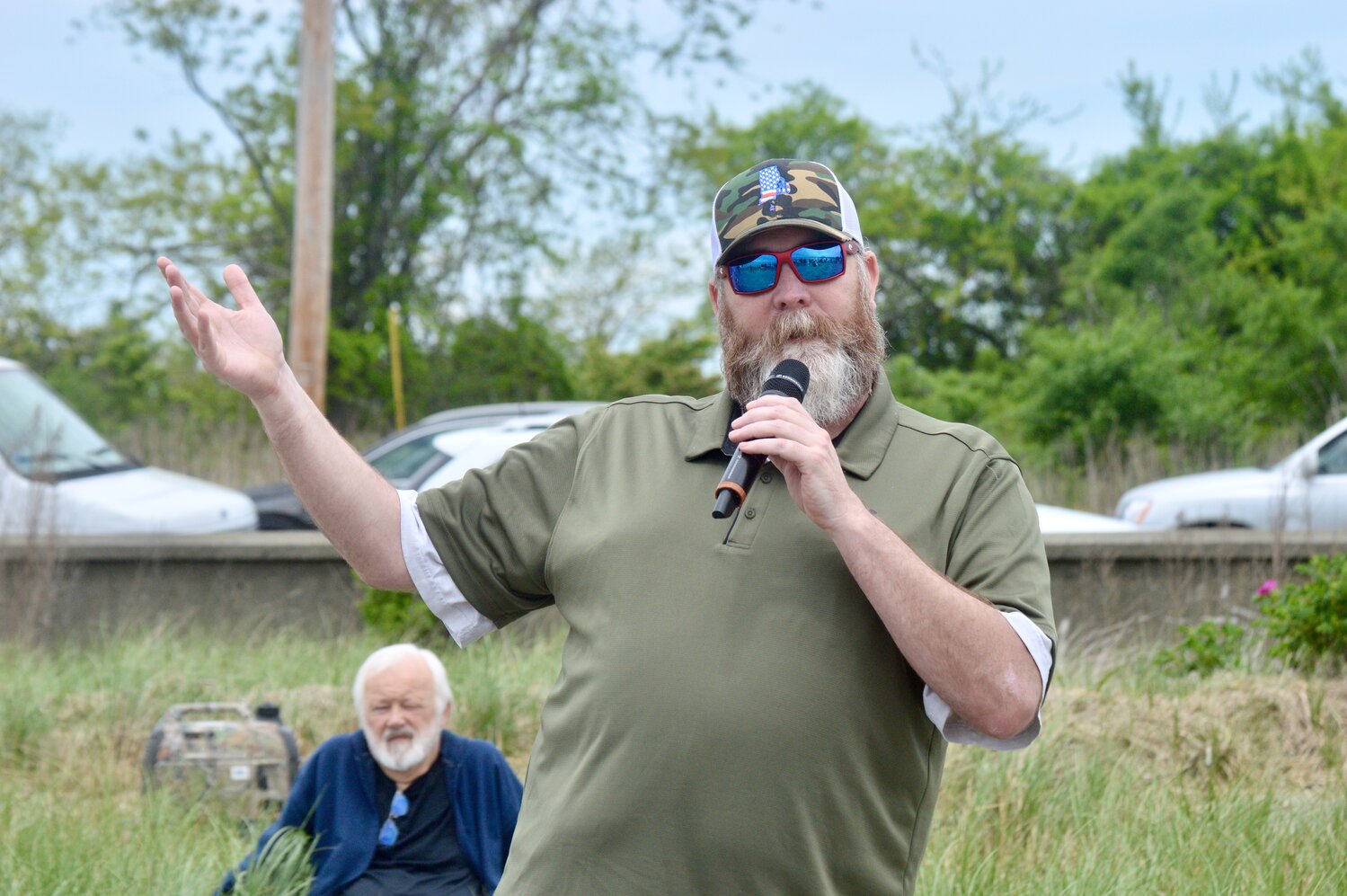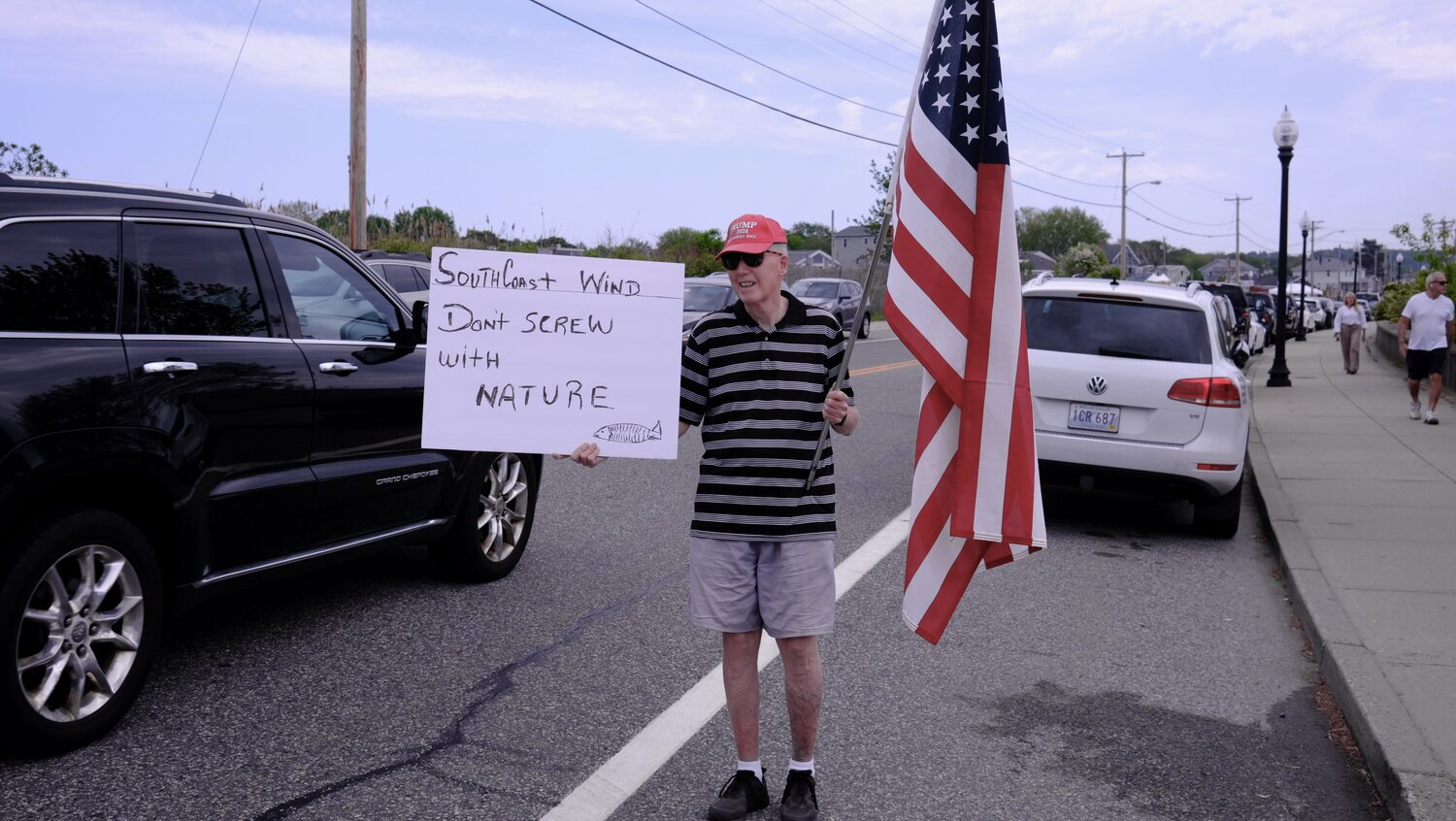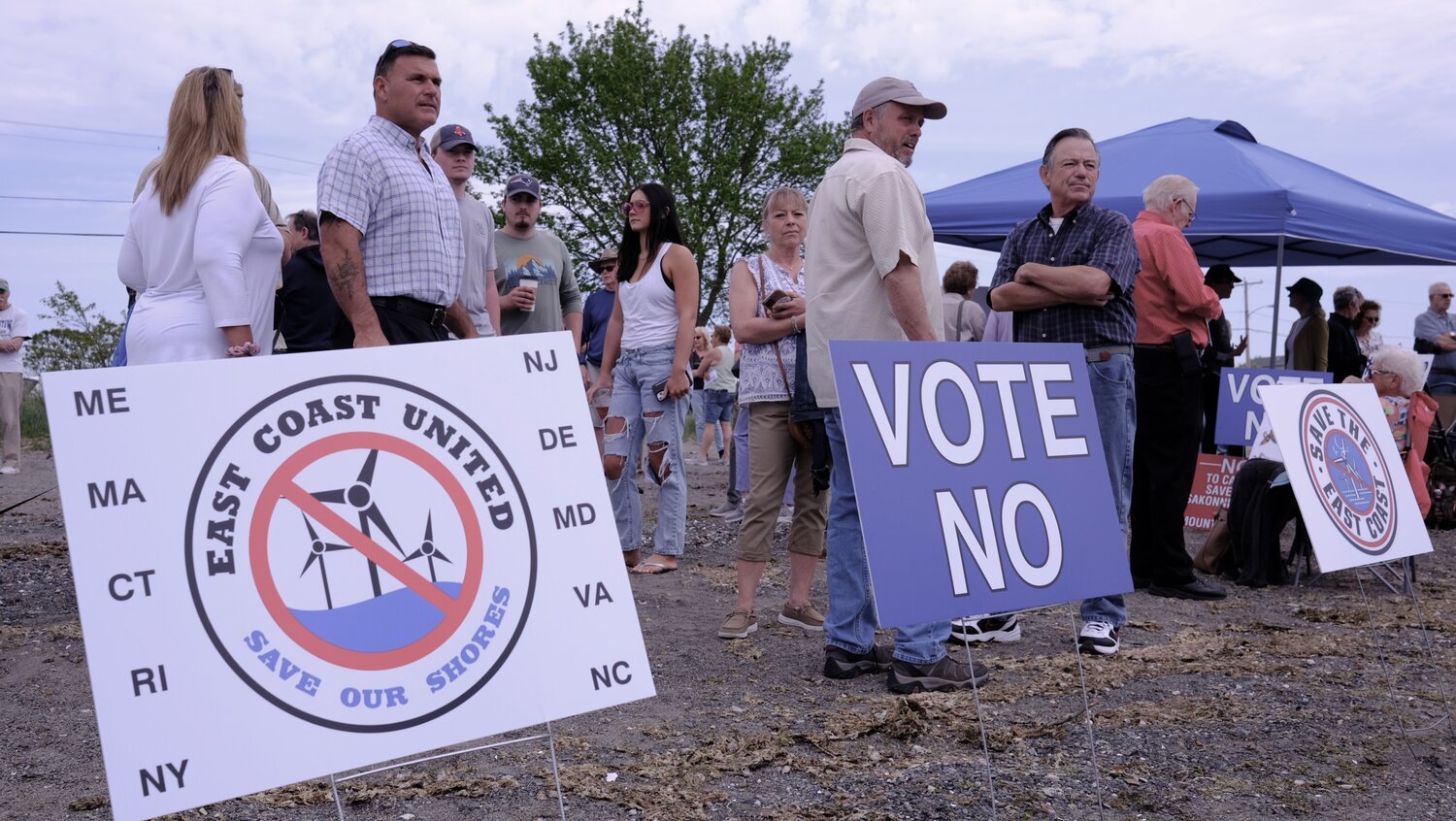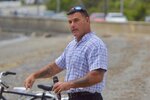- TUESDAY, JULY 16, 2024
In Portsmouth: A rally cry against offshore wind
About 90 people gather at Island Park Beach to condemn SouthCoast Wind’s proposal to run transmission cables up the Sakonnet River into Portsmouth
PORTSMOUTH — Bill Thompson pointed to the wind turbine at Portsmouth High School, just east of Island Park Beach where about 90 people gathered Saturday to rally against offshore wind.
…
This item is available in full to subscribers.
Please log in to continue |
Register to post eventsIf you'd like to post an event to our calendar, you can create a free account by clicking here. Note that free accounts do not have access to our subscriber-only content. |
Day pass subscribers
Are you a day pass subscriber who needs to log in? Click here to continue.
In Portsmouth: A rally cry against offshore wind
About 90 people gather at Island Park Beach to condemn SouthCoast Wind’s proposal to run transmission cables up the Sakonnet River into Portsmouth
PORTSMOUTH — Bill Thompson pointed to the wind turbine at Portsmouth High School, just east of Island Park Beach where about 90 people gathered Saturday to rally against offshore wind.
The machine, Thompson told the crowd, “serves as a daily reminder of the major transformation that’s about to take place off our coasts.”
Thompson, a Tiverton resident and one of the co-founders of the local grassroots organization Green Oceans, was referring to a proposal by SouthCoast Wind (formerly Mayflower Wind) to run transmission cables from an offshore wind farm up the Sakonnet River, beneath the beach where the rally was being held, up Boyds Lane and Anthony Road and over a golf course before reentering waters in Mt. Hope Bay and making final landfall in Somerset.
Many local residents are concerned such wind projects negatively impact the ocean ecology and hurt the local fishing industry, while not serving as a cure to climate change as promised.
On Saturday they gathered on the beach near signs that read “No to Cables — Save Our Sakonnet River & Mount Hope Bay,” “Vote No,” “Save Our Shores,” and others.
Karen Gleason served as emcee of the rally, which featured a dozen different speakers in an attempt to bring awareness of ongoing offshore wind projects currently being proposed. “We’re really here today to save our Sakonnet River, but also Mount Hope Bay,” she said.
Several residents tried to get on the Portsmouth Town Council agenda’s twice to discuss SouthCoast Wind’s plans, but were denied both times, said Gleason, the wife of council member Dave Gleason. The council, which has maintained there is no formal proposal from SouthCoast before the town at this time, has nevertheless scheduled a workshop on the matter for 7 p.m. on Thursday, May 25, at Portsmouth High School. Gleason urged everyone to attend.
Here’s a sampling of what the speakers had to say about SouthCoast’s plans specifically and wind energy in general. This story has been edited for space, but you can read a longer version at eastbayri.com.
Ralph Craft
Portsmouth fisherman, owner of Crafty One Customs
“I find it incredibly hard that you can tell me this is not going to affect the marine life, and you’re talking from squid, menhaden to bait fish basically, all the way through to stripe bass, tuna, cod, monk fish, scallops and all the way up to whales.”
Craft said he expects than anyone profiting from wind energy projects need to do their “due diligence in finding out what they’re going to do to the marine life … We have green energy, but then we have no more food. Who’s the energy for?”
He pointed out that the turbine at PHS is 300 feet tall. “The ones that are going to be out there are 1,066 feet — one third the size, and we’re talking about 1,500 to 2,000 of them.” They will be visible from the local shoreline, he said.
John Kourtesis
Portsmouth resident, commercial fisherman
“This beach, this ocean, this river, is our national park,” Kourtesis said. “This is everybody’s property. If you pay taxes, this is ours, and our government is leasing the bottom of our ocean. They’re leasing our national park to line their own pockets. That’s the crime.”
Kourtesis said he, too, was worried about wind energy’s impact on the ocean’s ecology as well as his business. “All these people fishing off the rocks who don’t care, they need to learn how to care because they’re not going to catch anything,” he said. “Every little species in our bay is going to be affected.”
While he applauded people for contacting their local town boards and politicians regarding wind energy, the real decisions will be made at the federal level, he said.
Lisa Quattrocki Knight
Little Compton resident, member of Green Oceans
Knight made three main points during her 18-minute speech:
• “Offshore wind is not green,” she said. “What is the point of trying to save the planet if we kill the wildlife, ruin the beauty, poison the people, and hurt our economy? We need real solutions to climate change — solutions that will actually decrease carbon emissions.”
• “Offshore wind will cause irreversible environmental damage without helping climate change.”
• “These projects will only hurt Rhode Island. Politicians will meet their political objectives, but we the people will have nothing to gain from them.”
Offshore wind developers, she said, are large, foreign corporations and often oil companies. “The have come to the U.S. to exploit our national treasure: the ocean. Even if our politicians are willing to sell our fisheries, our whales, our beaches and our waters, for a false proms, we cannot let this happen without a fight.”
Constance Gee
Westport resident
Gee spoke mainly about the impact she believes offshore wind has on marine mammals.
“The sonar survey they are using to site transmission cabling and offshore wind turbines causes harm and mortality to a range of animals,” Gee said, adding that the “intense noise” of pounding giant wind turbines deep into the seabed “along with the increase of ship traffic during construction and maintenance afterwards will do the same — disturb, injure and kill marine life.”
Marine animals, she said, depend on their hearing like humans depend on their sight. “Whales, dolphins, porpoises and seals are highly sensitive to sound. A deafened whale … in a shipping channel is likely a dead whale,” Gee said.
(Gee’s and other speakers’ comments regarding offshore wind development’s impact on whales and other ocean life run counter to many scientists’ findings: that seafloor surveys carried out in preparation for the installation of wind turbines have little or no connection to the strandings.)
Many organizations such as the National Audubon Society, Greenpeace and the Sierra Club “parrot the talking points” of the wind industry, from which they’ve taken money, she said.
“They are in it for the money and political gain. Of course they will tell you it is all about stopping climate change. As if killing the planet to save it is a solution,” Gee said.
Bill Thompson
Tiverton resident, co-founder of Green Oceans
Thompson also raised concerns over the impact the wind project would have on the Sakonnet River’s ecology, particularly how the transmission cables would impact species that rely on the earth’s electromagnetic fields for navigation. He questioned the accuracy of the Bureau of Ocean Energy Management’s claim that the undersea power cable will generate very low electromagnetic currents outside the range of marine life.
Thompson said 1,500 to 2,000 giant wind turbines will crowd federal waters just outside Rhode Island Sound, with nine separate lease areas totaling 900,000 acres — 1.5 times the size of Rhode Island’s land mass. It seems like Rhode Island and Massachusetts are “serving as guinea pigs for subsequent wind farms up and down the East Coast. It’s true that hundreds or thousands of jobs could be created by wind energy, but we don’t know the permanency of the jobs,” he said.
While a delayed response to climate change is not an option, “neither is a rushed solution full of unknowns and risks to the marine ecosystem. A healthy ocean is the first and best defense against climate change,” he said.
Gary Mataronas
Commercial fisherman, longtime member of Little Compton Town Council
Mataronas said his Town Council passed a resolution opposed to SouthCoast’s cable coming up the Sakonnet River and asked why it couldn’t go along Route 88 on land.
“We have many fishing boats that sail out of Sakonnet Harbor, How will these be impacted while laying the cable? Are we going to be allowed to go out of the harbor?”
Fishermen are concerned about electromagnetic currents given off by the cables, said Mataonas. All fish, especially crustaceans, are very sensitive to them, he said.
“They will disperse from any area that generates electrical currents. Will the cables give off electric currents that will disperse our sea life? I asked that question and it was never answered,” he said.
Christopher Brown
Commercial fisherman from Point Judith, president of Seafood Harvesters of America
“We all own the ocean. Joe Biden doesn’t own the ocean. Our oceans will never be the same once they’ve created these monstrosities,” said Brown. “In this scenario, the ocean and the fishing and coastal communities will grow poorer as a result of a lack of stewardship, care, concern or codification by our government.”
Brown claimed the SouthCoast project lacks adequate environmental safeguards, and he questioned the role of the Bureau of Ocean Energy Management (BOEM).
“How the hell can BOEM not have the responsibility that the citizens who it represents ask of it? They have the right to ignore the Endangered Species Act that we voted for in 1966. They have the right to ignore the Marine Mammal Protection Act of 1972. They have the right to run roughshod over the Magnuson-Stevens Fishery Conservation and Management Act that adopted in 1976,” said Brown, who took shots at President Joe Biden and U.S. Sen. Sheldon Whitehouse for their support of wind energy. “This is simply a portal to wealth. It’s not a cure to climate change,” he said.
Dave Moriarty
Resident of Falmouth, Mass.
“Our Board of Selectmen have said ‘no’ to SouthCoast Wind. Our town meeting has said ‘no’ to SouthCoast wind, and they’re still negotiating behind closed doors. Whatever your politicians tell you, it doesn’t mean a thing. They’ve been lying to us for years. Never believe a wind developer. If their lips are moving, they’re lying.”
Rep. Patricia Morgan
Republican state lawmaker representing West Warwick, Coventry, Warwick
“I’m concerned about the environmental degradation that’s going to be happening. More than that, I’m concerned about your quality and standard of living,” she said. “Don’t call them farms; they are not farms.”
Rose Willis
New Jersey resident, member of Save the East Coast
“We have seen 17 whale deaths in New Jersey and New York and roughly 29 dolphin stranding deaths since December,” said Willis, who attributed those deaths to offshore wind development.
“You have 10 years of construction and pile-driving and then plowing the ocean floor. What is going to survive after that? And then they want to run the cables throughout neighborhoods.”
Keywords
SouthCoast Wind, Mayflower Wind, offshore wind, green energy, renewable energyOther items that may interest you









































